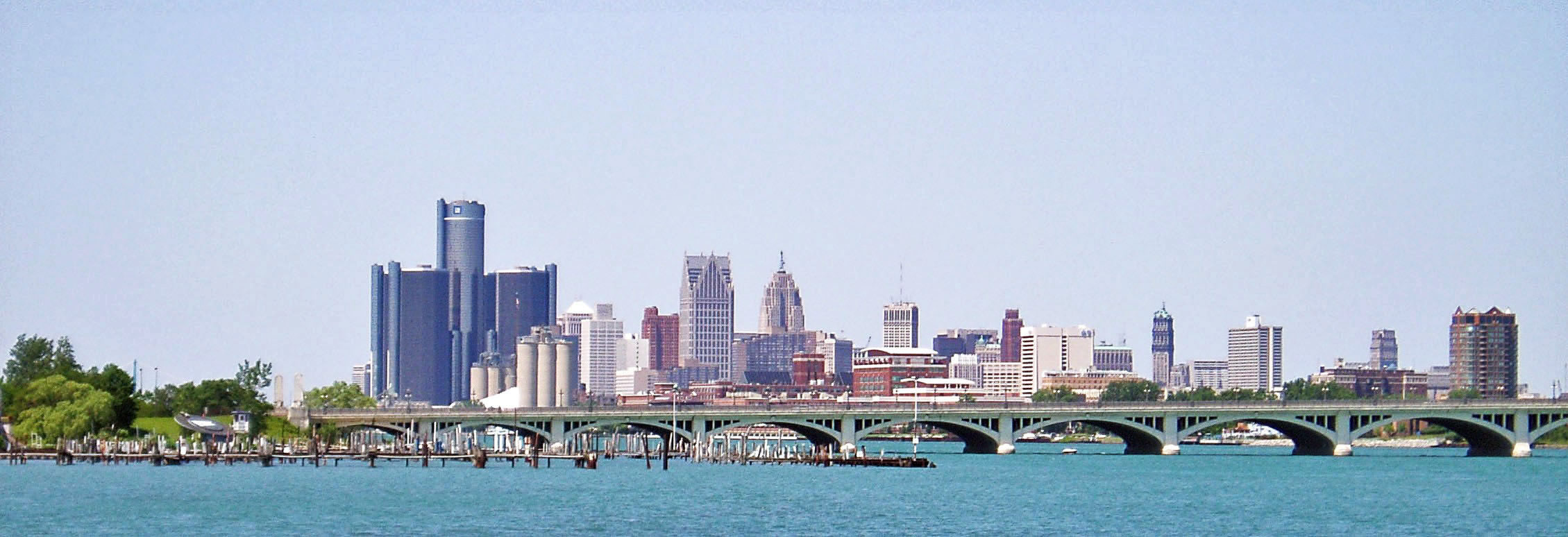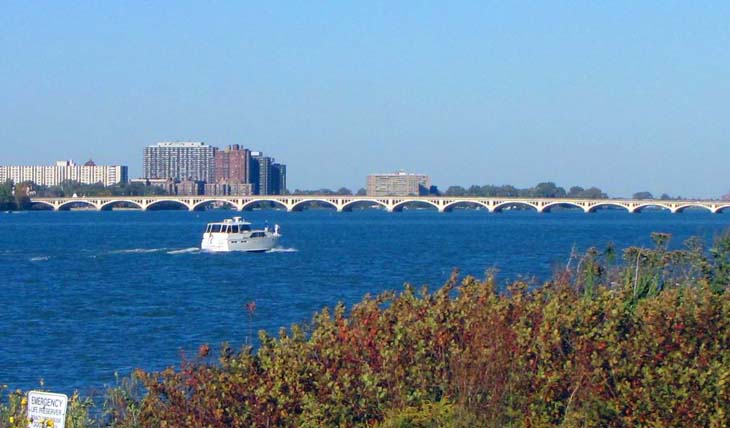
Belle Isle Bridge/General Douglas MacArthur Bridge
Spanning part of the Detroit River from East Jefferson Avenue on
the West
to Belle Isle on the East
This is one of the more attractive bridges that you will find in the large cities of the United States or Canada. There are quite a few noteworthy bridges so I will not say that this ranks among the most attractive dozen or so. It is, however, a very graceful structure that conveys an image of the pleasant green environment of Belle Isle.
Belle Isle has a long and interesting history. Presumably, Indians visited the island over the course of many centuries. When the French settled these straits, they visited the site but found many rattlesnakes. They had an excellent solution. They fattened their pigs there, a process that got rid of the snakes and gave the site its first European name: “Ile aux cochons.” In 1768, British Lieutenant George McDougall purchased the island from Chippewa and Ottawa Indians, thereby  becoming the first westerner to hold title to the 700 or so acres. In 1793, the prosperous English trader and settler, William Macomb, purchased one-half the island, and then the next year, he bought the other half from George McDougall. His heirs, in 1817, sold the island to Barnabas Campau, a descendent of one of the early French ribbon farm owners. In 1845, the French name was supplanted by the name Belle Isle to honor the daughter of former territorial governor and Detroit developer, Lewis Cass. In 1851, the first summer resort was built on the island. I do not know if this was just a location that people visited for a day or if it provided hotel space. In 1864, the widow of Barnabas Campau married a Detroit real estate investor, R. Storrs Willis for whom the Willis-Selden Historic District is named. They built the first modern house on the island, a white frame structure that still stands and is now used by Belle Isle administrators.
becoming the first westerner to hold title to the 700 or so acres. In 1793, the prosperous English trader and settler, William Macomb, purchased one-half the island, and then the next year, he bought the other half from George McDougall. His heirs, in 1817, sold the island to Barnabas Campau, a descendent of one of the early French ribbon farm owners. In 1845, the French name was supplanted by the name Belle Isle to honor the daughter of former territorial governor and Detroit developer, Lewis Cass. In 1851, the first summer resort was built on the island. I do not know if this was just a location that people visited for a day or if it provided hotel space. In 1864, the widow of Barnabas Campau married a Detroit real estate investor, R. Storrs Willis for whom the Willis-Selden Historic District is named. They built the first modern house on the island, a white frame structure that still stands and is now used by Belle Isle administrators.
In the post-Civil War decades, as many American cities became dirty and congested industrial centers, there was a great park-building movement that produced what are today some of the nation’s finest parks such as Central Park in New York, Fairmount Park in Philadelphia, Prospect Park in Brooklyn and Mount Royal in Montréal. Detroit joined in this great park building campaign. The city purchased Belle Isle from the state of Michigan for $180,000 on September 23, 1879. Two years later, Detroit Common Council designated the island a park and, on August 29, 1881, they commissioned Frederick Law Olmstead—the nation’s most accomplished landscape architect—to design the facility.
At the start, people reached the park from the mainland by boat. Indeed, I believe that some boat service continued to operate through the World War II years. In 1889, however, a modest bridge linked the east side of Detroit to Belle Isle. On April 27, 1915, workmen were using a steamroller to repair the deck of bridge. They had attached a bucket of hot coals to heat the tools they used to smooth the asphalt. Unfortunately, it was a very bad day for them. Some of their hot coals fell upon the wooden planking of the bridge. Two Detroit fire boats and 13 Detroit fire companies responded and a great crowd gathered. Quickly, the bridge burned to the water line. This was an iron bridge but the heat of the burning plants contorted the iron such that the bridge could not be repaired. A substitute bridge was hastily erected. At this time, however, Detroit was a prosperous city benefitting greatly from the burgeoning vehicle industry. Thus the city was able to commission the truly spectacular bridge you see, one that is appropriate for one of the most interesting parks in the country.
There are 19 spans in this bridge. If you run across its sidewalks or ride your bicycle across, you will not realize how great the rise is until you get to the crest at the center. This is a cantilevered concrete arch structure. Each half of each arch is cantilevered so it is not joined to the other half of the same arch. Certainly, the arches look like they are complete. However, if you were to run under the bridge, you would see that there is a gap between the two halves of every arch. The Belle Isle Bridge was, apparently, among the first three cantilevered arch bridges erected in the United States.
The total length of the bridge is 2,356 feet with a roadway width of 61 feet. Street car lines were never laid across the bridge but there was a turning point for such cars at the mainland foot. The bridge was rehabilitated in 1984 and then again in 1998.
In 1942, the bridge was named for General Douglas MacArthur. However, it is still widely known as the Belle Isle Bridge.
This bridge was designed by Detroit born architect Emil Lorch who played a considerable role in popularizing modern American or Prairie style architecture in last century. Born in Detroit in 1870, Lorch studied at the Detroit School of the Arts and then at the Massachusetts Institute of Technology. He practiced as an architect in Boston then returned to Detroit to take an appointment as head of the Detroit School of the Arts. However, Detroit publisher James Scripps sent Lorch to represent Detroit at a conference in Belgium focued upon beautifying cities. When Lorch returned he found the Detroit School of the Arts had closed its doors. Lorch went to Chicago and taught at the Art Institute there. I believe this is where he became famaliar with the efforts of Louis Sullivan and others to popularize a modern American style of architecture.
In 1906, the University of Michigan initiated a program in architecture. That subject had been taught in Ann Arbor but, previously, there was no formal program. Emil Lorch was appointed to head the program and, in 1931, that University established a School of Architecture with Lorch as its first dean. Lorch played a role in the design of Cranbrook. In the early 1920s, he convinced the innovative Finnish architect, Eliel Saarinen, to come to the University of Michigan. When, later that decade, George Booth established the Cranbrook School of the Arts, Saarinen was selected as the architect. So far as I know, Lorch did not design many buildings. He designed the architecture building for the University of Michigan and an Ann Arbor dam on the Huron River. The General Douglas MacArthur Bridge is a real tribute to his skill.
Date of Completion: 1923
Architect: Emil Lorch
Style: Cantilevered concrete arch bridge
Use in 2017: Bridge over water
City of Detroit Designated Historic District—Not listed
State of Michigan Registry of Historic Sites; Belle Isle: listed September 10, 1979, # P25,046
National Register of Historic Places: Belle Isle: listed April 25, 1974 #74000994
Website for Belle Isle: http://www.fobi.org/
Website for the Belle Isle Bridge: http://www.historicbridges.org/other/Belle/
Description updated: April, 2017
Return to Federal Register of Historic Districts
Return to National Register of Historic Structures
Return to Homepage